ho8y
hbv;
kjlbj
ho8y
hbv;
kjlbj
jchhugyb
njfduzhd
jifahh
jifaohfduahuha
fndauuafid
20%
The extra body fat burned by subjects exercising in a fasted state over those who ate breakfast before training, according to Northumbria University
45
minutes of moderate-tovigorous exercise in the morning reduced people’s motivation for unhealthy food later that day, according to research published in the journal Medicine And Science In Sports And Exercise
To burn fat quickly you need to be in a daily calorie deficit so your body is forced to tap into existing fat stores and free their energy for fuel. And the good news is that you can accelerate your fat loss without doing any more exercise simply by working out before breakfast. In a new study from Northumbria University, subjects who trained first thing on an empty stomach burned around 20% more body fat than those subjects who had breakfast before exercising. What’s more, those who did a morning “fasted cardio” session – as it’s known – did not consume any more calories over the course of the rest of the day than those who’d trained after breakfast. So if you want to lose body fat faster, wake up, have a strong black coffee and then go for a run or ride.
If you have tried and failed in the past to make major changes to how you look with your top off, now is the time to make some major changes to the way you train. And making the requisite changes to your weights workouts couldn’t be easier thanks to this four-week workout that – if followed to the letter – will help add serious size and strength across your torso while also stripping away excess body fat to transform what you see in the mirror. The beauty of this plan is that you’ll train all the major upper-body muscles – chest, shoulders, arms and back – twice a week. That means the sessions are going to be tough, but with focus and dedication you’ll see your body change shape fast.
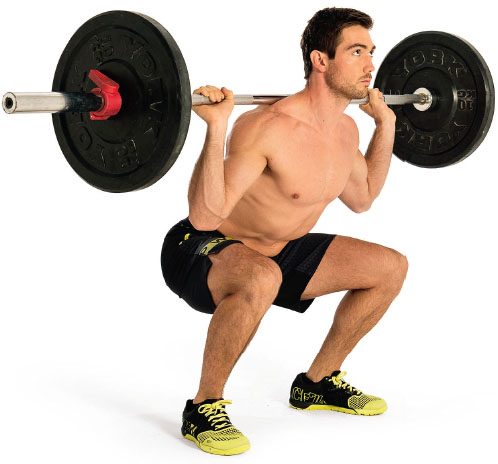
This month’s four-week workout is made up of four sessions a week. Workout one targets your chest and back; workout two, your legs and shoulders; workout three, your chest and triceps; and workout four, your back and biceps. If that sounds like a lot of training time dedicated to your major upper-body muscles, that’s because it is. Training these important muscle groups either directly or indirectly twice a week is likely to be a significant increase in the amount of work you are asking them to do – and it’s this increase in training volume that will propel your body out of its comfort zone so that it is stimulated to add lean muscle mass quickly, while the extra demands will target your fat stores to burn them for energy.
Each workout is made up of five lifts which you will perform as straight sets. This means you do all the sets of the first lift, rest and then move on to the second lift and so on. Simply do the workouts in order, sticking to the sets, reps, tempo and rest periods detailed. Each week try to lift slightly heavier than before, but make sure that you prioritise maintaining good form for every rep of every set.
To get the full effect from these workouts, you need to stick to the four-digit tempo code for each exercise. The first digit indicates how long in seconds you take to lower the weight, the second how long you pause at the bottom of the move, the third how long you take to lift the weight, and the final digit how long you pause at the top. The accumulated time under tension increases your heart rate to burn body fat and break down muscle tissue so it’s rebuilt bigger and stronger. Keep each rep smooth and controlled so your muscles – not momentum – do the work, and move through a full range of motion.
Here’s how each week is structured
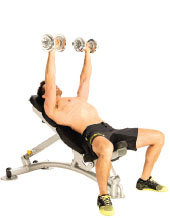
WORKOUT 1
CHEST AND BACK
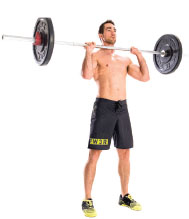
WORKOUT 2
LEGS AND SHOULDERS
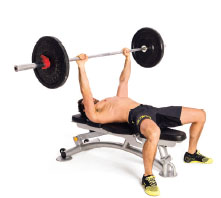
WORKOUT 3
CHEST AND TRICEPS
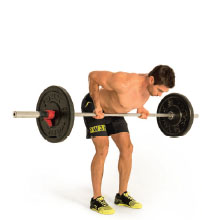
WORKOUT 4
BACK AND BICEPS
Sets 4 Reps 12 Tempo 2010 Rest 60sec
Lie on a flat bench, holding a barbell with an overhand grip with your hands slightly wider than shoulder-width apart. Brace your core and press your feet into the ground, then lower the bar towards your chest. Press it back up to the start.
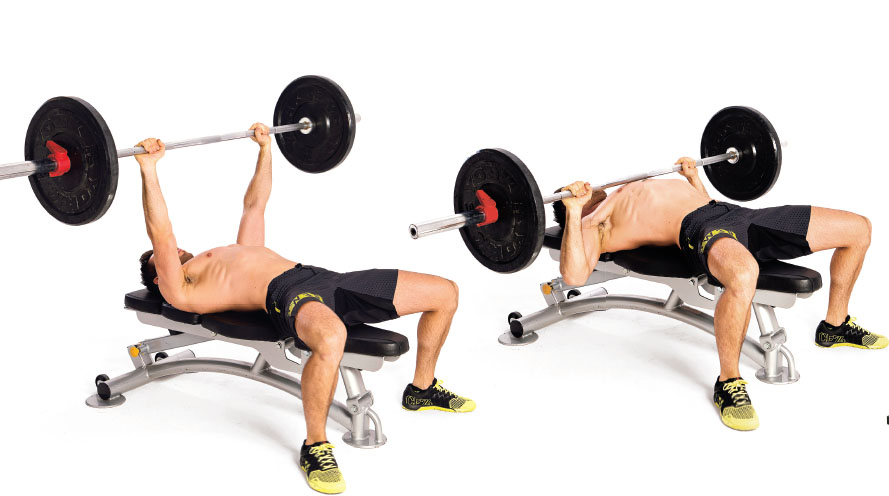
Sets 4 Reps 12 Tempo 2011 Rest 60sec
Hold a barbell using a shoulder-width overhand grip just outside of your legs. Bend your knees slightly, then bend forwards, hingeing from the hips and keeping your shoulder blades back. Pull the bar up towards your abs, leading with your elbows, then lower it back to the start.
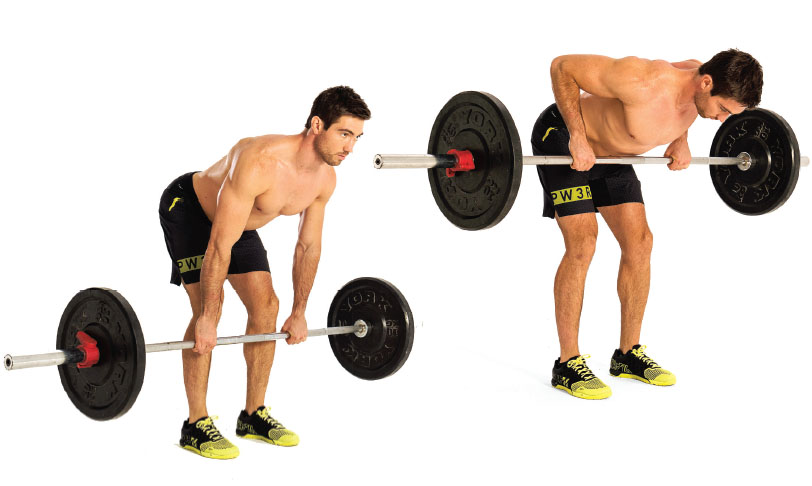
Sets 4 Reps 8-12 Tempo 2011 Rest 60sec
Hold a chin-up bar using a shoulder-width underhand grip. Brace your core, then pull yourself up until your chin is higher than the bar, keeping your elbows tucked in to your body. Lower until your arms are straight again.
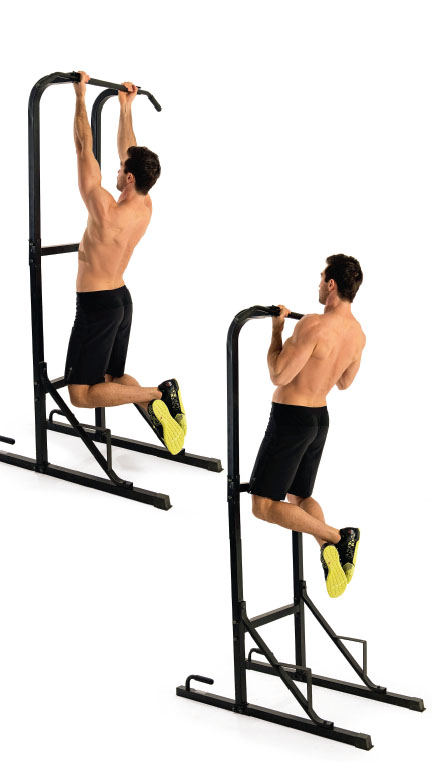
Sets 4 Reps 12 Tempo 2010 Rest 60sec
Lie on an incline bench holding a dumbbell in each hand above your face, with your palms facing and a slight bend in your elbows. Lower them to the sides, then bring them back to the top.
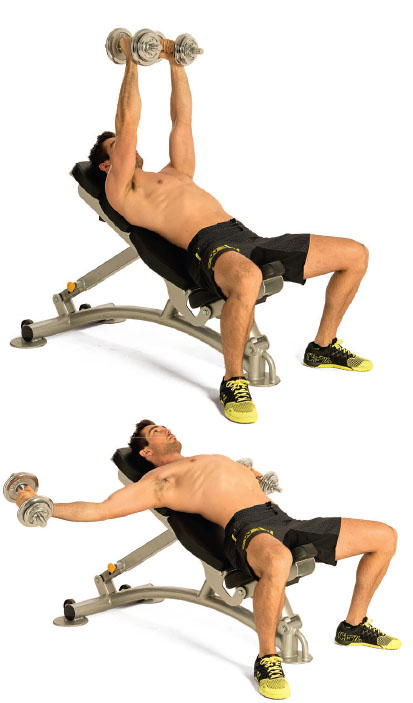
Sets 4 Reps 12-15 Tempo 2010 Rest 60sec
Start in a press-up position but with your thumbs and index fingers touching to form a diamond. Keeping your hips up and core braced, bend your elbows to lower your chest towards the floor. Push down through your hands to return to the start.
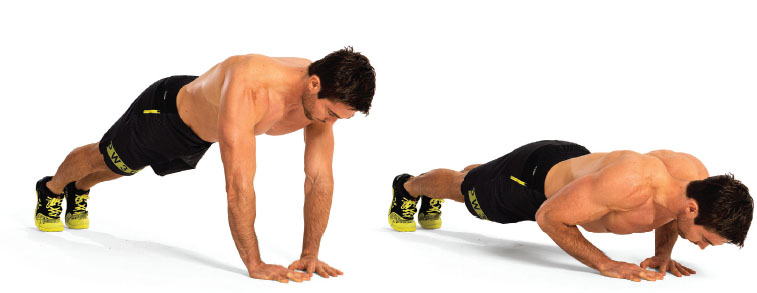
Sets 4 Reps 12 Tempo 2010 Rest 60sec
Stand tall with your feet just wider than shoulder-width apart, holding a barbell across the back of your shoulders. Keeping your chest up and core braced, squat down until your thighs are at least parallel to the floor. Drive back up through your heels to return to the start.
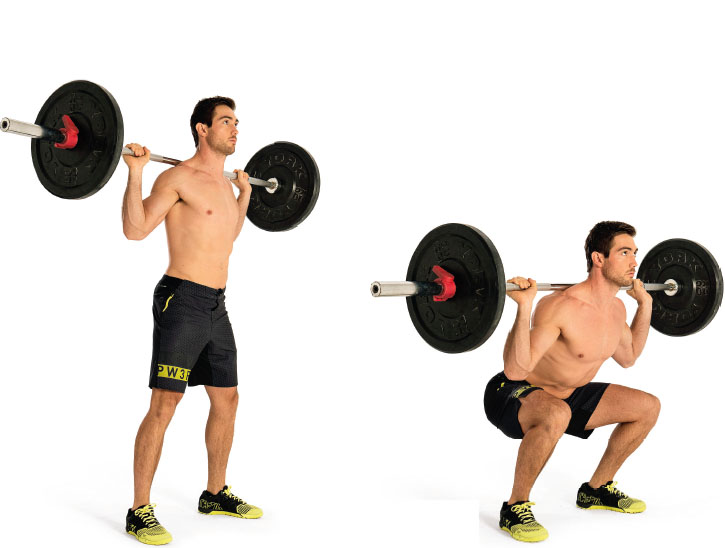
Sets 4 Reps 12 Tempo 2010 Rest 60sec
Stand tall with your feet shoulder-width apart, holding a barbell across the top of your chest with hands slightly wider than shoulder-width apart. Keeping your chest up and core braced, press the bar overhead until your arms are straight, then lower it back to the start.
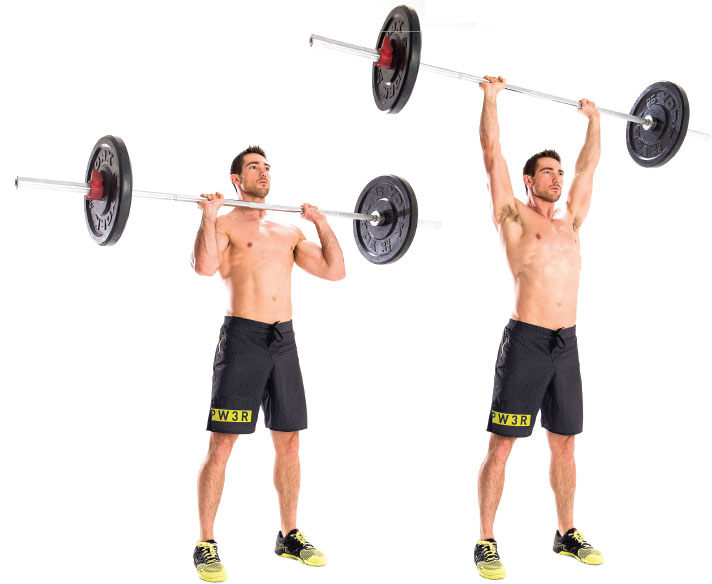
Sets 4 Reps 6 each side Tempo 2010 Rest 60sec
Stand tall with feet just wider than shoulder-width apart, holding a bar across the back of your shoulders. Keeping your chest up, take a big step forwards with your right foot, then lower until both knees at bent at 90°. Drive back through your right foot to return to the start. Repeat for six reps, then switch legs and do another six reps with your left foot forward.
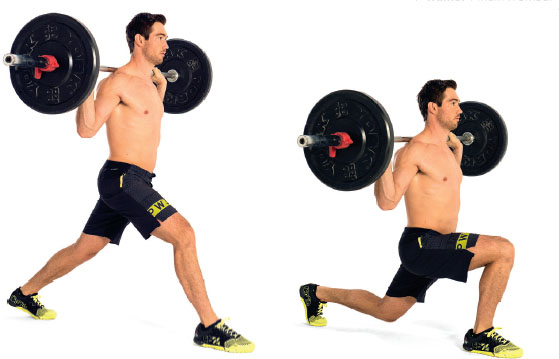
Sets 4 Reps 12 Tempo 1010 Rest 60sec
Stand tall with your feet shoulder-width apart, holding a barbell with an overhand grip and straight arms. Keeping your chest up and core braced, pull the bar upwards, leading with your elbows, until it reaches chin height. Then lower it back to the start.
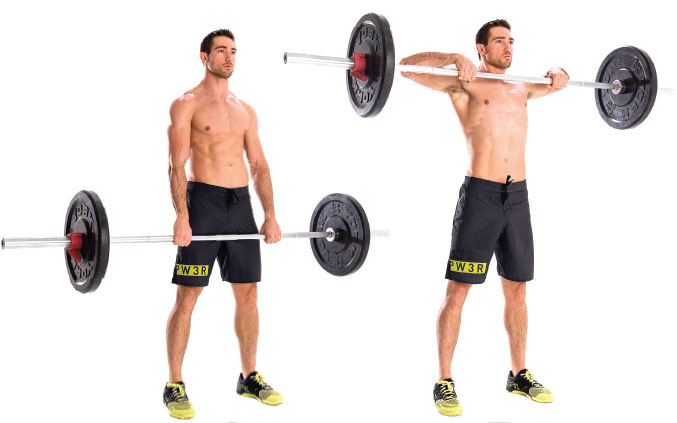
Sets 3 Reps 12-15 Tempo 2011 Rest 60sec
Stand tall, holding a light dumbbell in each hand by your sides, palms facing each other. Keeping your chest up, your core braced and a slight bend in your elbows, raise the weights out to shoulder height. Turn your thumbs down at the top, then lower them back to the start.
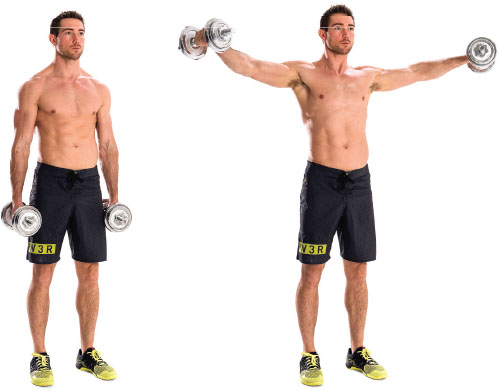
Sets 4 Reps 12 Tempo 2110 Rest 60sec
Lie on an incline bench, holding a bar with an overhand grip with your hands slightly wider than shoulder-width apart. Brace your core and press your feet into the ground, then lower the bar towards your chest. Press it back up to the start.
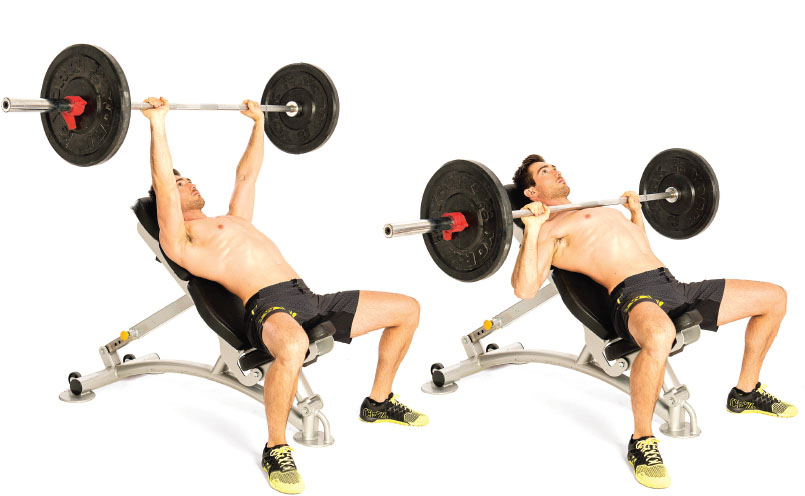
Sets 4 Reps 12 Tempo 2010 Rest 60sec
Sit on an upright bench holding a dumbbell in each hand at shoulder height, palms facing forwards. Keeping your chest up, press the weights directly overhead until your arms are straight, then lower them back to the start.
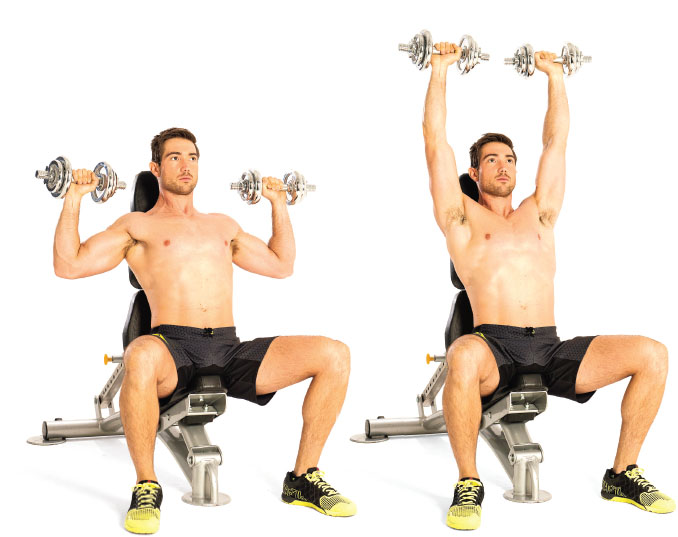
Sets 4 Reps 12 Tempo 2010 Rest 60sec
Lie on a flat bench, holding dumbbells by your shoulders with palms facing. Drive your feet into the floor and press the weights straight up, then lower them slowly back to the start.
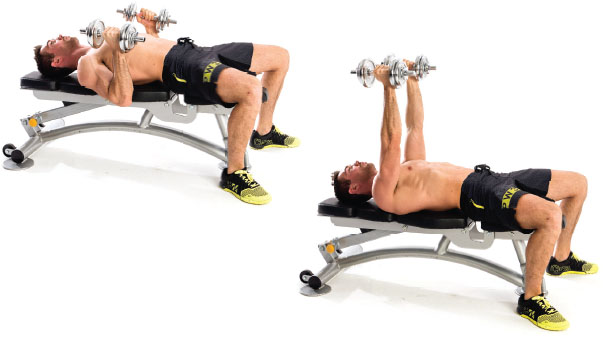
Sets 4 Reps 12 Tempo 2010 Rest 60sec
Stand tall holding a dumbbell in each hand over your head, with arms straight. Keeping your chest up, core braced and elbows pointing up, lower the weights behind your head, then lift it back to the start.
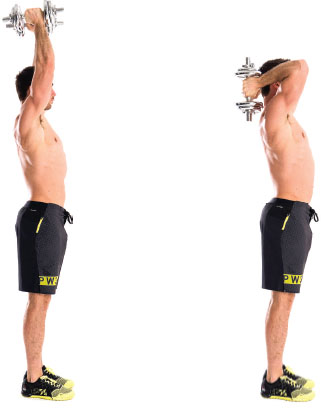
Sets 4 Reps 12-15 Tempo 2010 Rest 60sec
Start in a press-up position but with your thumbs and index fingers touching to form a diamond. Keeping your hips up and core braced, bend your elbows to lower your chest towards the floor. Push down through your hands to return to the start.
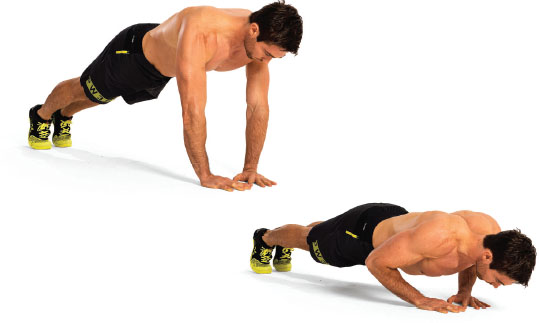
Sets 4 Reps 6-12 Tempo 2011 Rest 60sec
Hold a pull-up bar using an overhand grip with hands slightly wider than shoulder-width apart. Brace your core, then pull yourself up until your chest touches the bar. Lower until your arms are straight again.
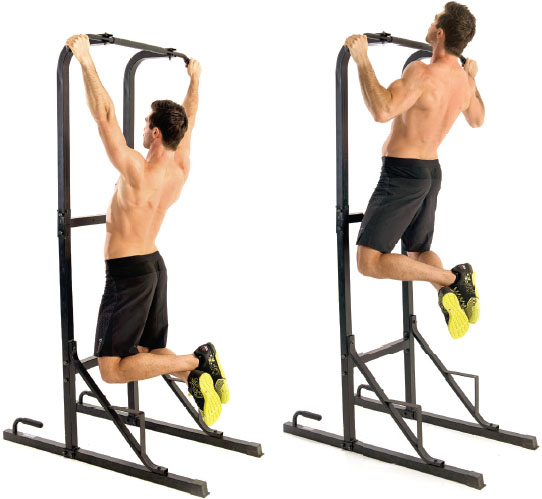
Sets 4 Reps 8-12 Tempo 2011 Rest 60sec
Hold a chin-up bar using a shoulder-width underhand grip. Brace your core, then pull yourself up until your chin is higher than the bar, keeping your elbows tucked in to your body. Lower until your arms are straight again.
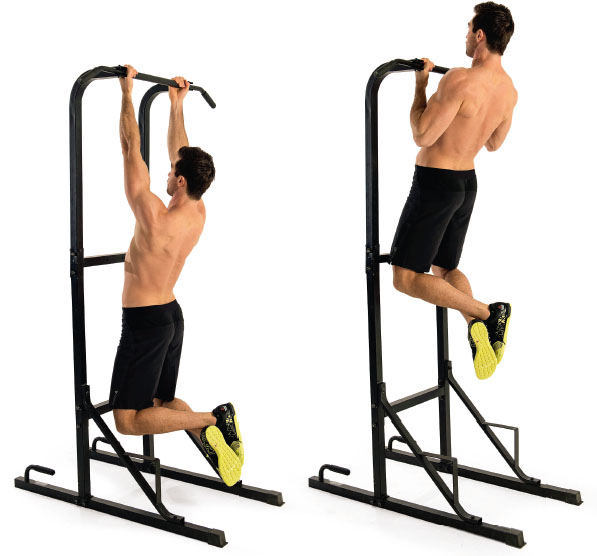
Sets 4 Reps 12 Tempo 2011 Rest 60sec
Hold a barbell with an underhand grip with your hands shoulder-width apart. Keeping your chest up, core braced and elbows tucked in to your sides, curl the bar up to your chest, squeezing your biceps as you go. Lower it back to the start.
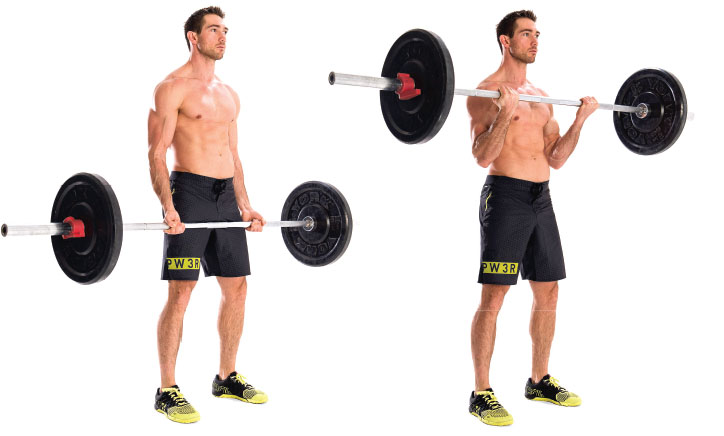
Sets 4 Reps 12 Tempo 2011 Rest 60sec
Hold a bar using a shoulder-width underhand grip just outside of your legs. Bend your knees slightly then bend forwards, hingeing at the hips and keeping your shoulder blades back. Pull the bar up towards your abs, leading with your elbows, then lower it back to the start.
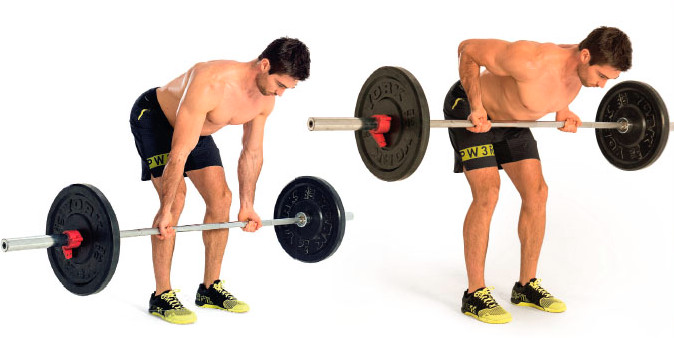
Sets 4 Reps 12-15 Tempo 2011 Rest 60sec
Hold dumbbells by your sides with straight arms, palms facing forwards. Keeping your chest up, core braced and elbows tucked in to your sides, curl the weights up, squeezing your biceps as you go, then lower them back to the start.
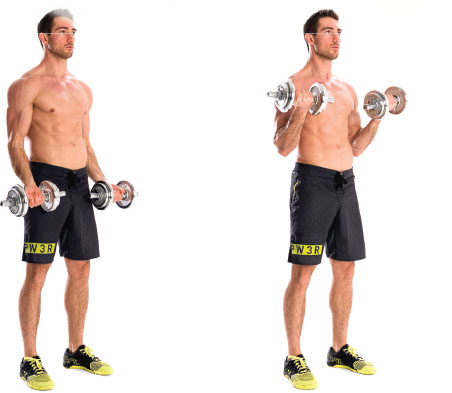
When most people start training for a running race, they make some common mistakes that can hamstring their efforts. MF’s editorial director, Joe Warner, is running the 2017 Virgin Money London Marathon for Parkinson’s UK and has enlisted the expert advice of elite runner Shaun Dixon (letsgetrunning.co.uk) so he – and you – can avoid the errors many people make and start to train like an elite athlete.
The more time you dedicate to training, the better runner you’ll become. But that doesn’t mean all sessions should be spent running. Think like an athlete – that means improving strength and mobility so you can run faster for longer and reduce the risk of injury.
If you want to be speedy, first get stronger. Training to build strength in your glutes, legs and core, improving your hip, knee and ankle strength and mobility, and working towards better flexibility should all form part of your training plan.
You don’t have to smash every workout. Intense interval sessions and long runs are important pillars in a training plan but too much too often will fatigue you physically and mentally. Include some comfortable steady-state work and recovery runs.
Try evaluating your runs on duration and effort level, not just distance. Too much focus on the kilometres you’ve clocked up will limit your progress. No two equal-distance runs are the same: terrain, weather and your energy levels and mood all have an effect.
Elite runners do a lot of speed work, and to run a fast marathon you need to be running fast 10Ks. Hill running (up or down), sprint sessions and intervals will improve your running economy and speed, and make it easier to run longer distances.
Alex Cannon knows a thing or two about building a strong and lean body. Just look at him. And you’re in luck because this month’s cover star is going to share some of his top training secrets so you can start building your best ever body too.
“I was so skinny as a kid, but when I started working out I could see major body changes – and when you put that effort in it really does become addictive, in a good way,” says the 27-year-old Liverpudlian. Before appearing in Celebrity Big Brother last summer, Alex starred alongside Geordie Shore star Vicky Pattison in her spin-off series Judge Geordie, where she helped settle family feuds. But despite his growing fame and legion of fans – 400,000 on Instagram alone – Cannon remains focused on helping others find their fitness.
“When I get messages from people saying thank you for having motivated, inspired or helped them in any way, that’s the best feeling there is. I think that’s all people really remember when you’re gone – how you made them feel,” he says. Turn the page for Cannon’s muscle-building and fat-torching tips.
Use Alex Cannon’s tried-and-tested training and diet advice to get lean fast
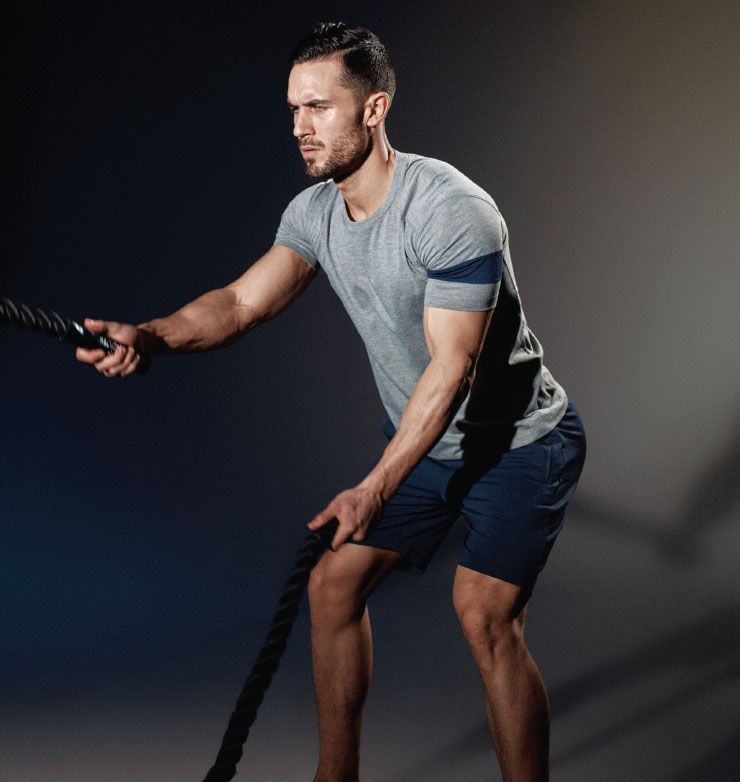
“You are what you eat. In other words, it doesn’t matter how hard you’re pushing it in the gym if you don’t put the same effort into what you do in the kitchen,” says Cannon. “Everyone says you can’t out-train a bad diet and it’s true. To strip fat you need a healthy, sustainable nutrition plan that works for you.”
“You need to burn body fat to reveal your six-pack, and your fat-loss training should be focused on lifting weights. This will help you add muscle mass while also forcing your body to burn its fat stores. There’s no way you’ll get ripped doing just cardio – but some short, intense cardio sessions can help.”
“I like to do some high-intensity cardio ‘finishers’ at the end of my weights workout – it pushes my heart, lungs and muscles as hard as possible and burns even more calories. Try some sets of battle ropes [pictured above], kettlebell swings or prowler pushes and you’ll melt that belly fat away.”
STAY IN THE ZONE
“Weight training for fat loss is pretty hard on both your body and mind, but you are really going to have to work if you want to make major changes to your body composition. The going will get tough sometimes. When it does, remind yourself of all the positive reasons you’re doing this, then dig deep.”
Follow these three tips to train your biceps smarter and you’ll start adding size and strength to your arms the next time you hit the gym
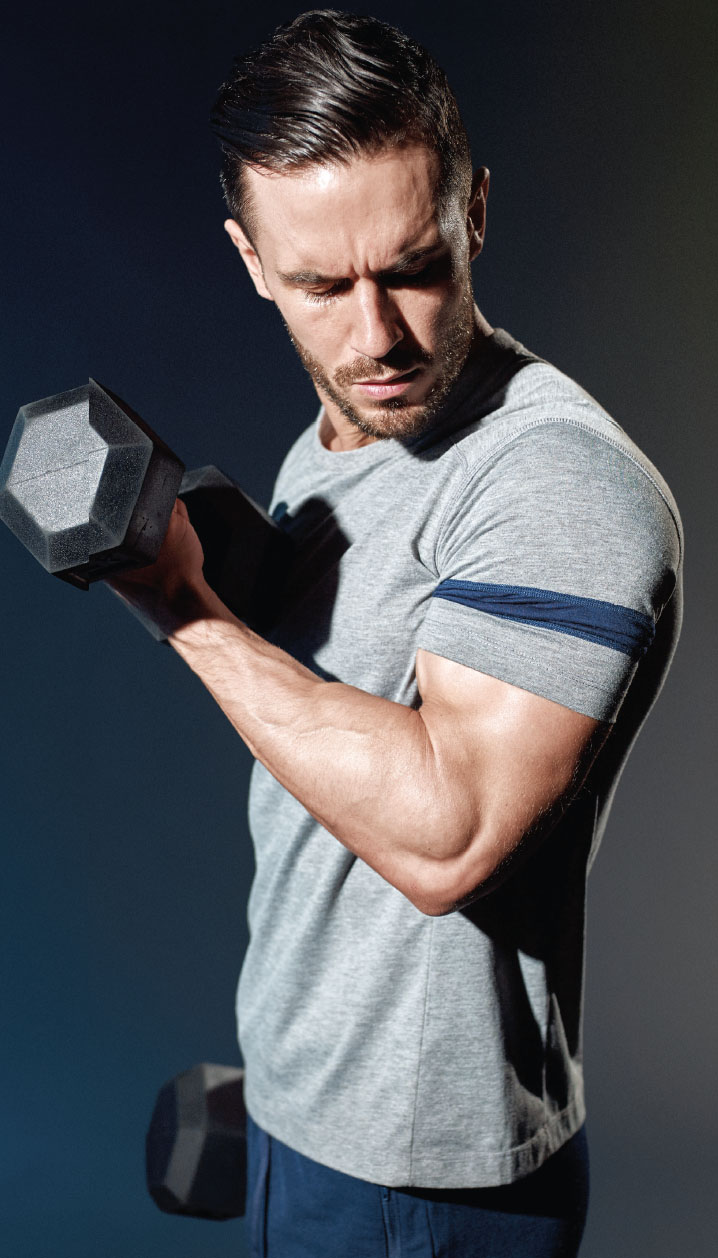
“I see one thing all the time in gyms all over the country, and that’s guys trying to biceps curl a dumbbell that’s far too heavy,” says Cannon. “It might look impressive from a distance, but they’re never fully engaging the biceps because they are swinging the weight up and down so there’s never tension on the muscle. You need to pick a lighter but still challenging weight and make sure you lift it properly, keeping your form good on every rep.”
“At the top of each biceps curl movement, whether it’s with a dumbbell, a barbell, an EZ-bar or even a chin-up, try to hold the top position and focus on squeezing your biceps hard. If you do you’ll recruit more of the muscle fibres in the biceps, and that means your arms are working harder during every single rep. And when you lower the weight again, make sure you’re doing it slowly and under control, so you maximise the amount of tension your biceps is exposed to. It will make a huge difference to how big, and how quickly, your biceps grow.”
“When I train my biceps I always try to make a strong connection between my brain and the muscle. It might sound weird but it makes such a difference in the quality of the rep. Thinking about how a working muscle is moving and controlling a weight keeps your form nice and strict, and it also helps activate more muscle fibres so you get better results.”
Get abs of steel by working this important muscle group in new and challenging ways that will keep you progressing
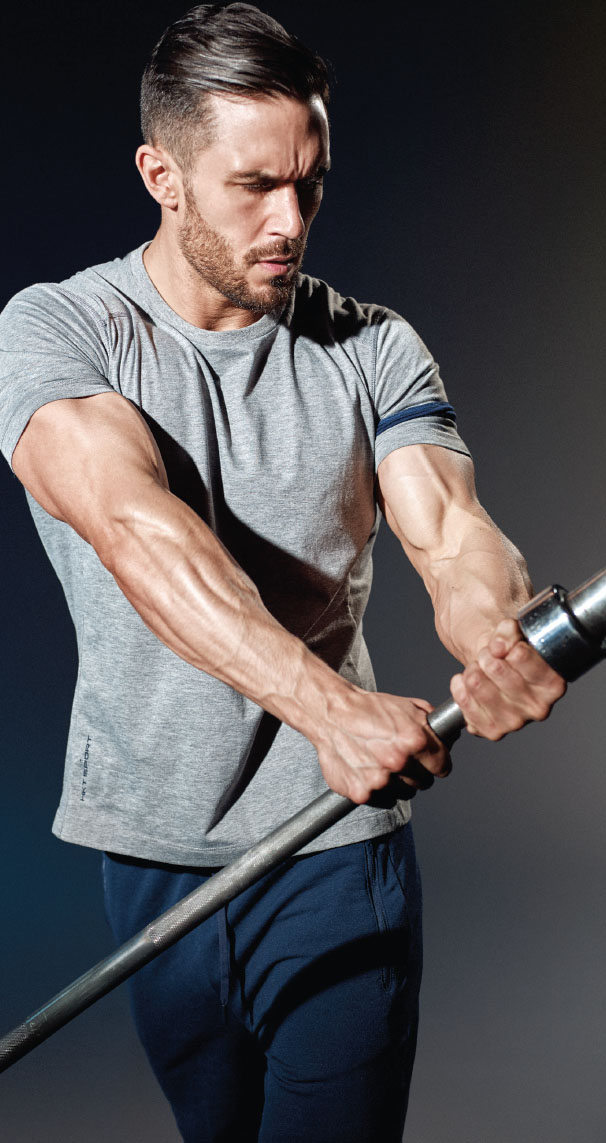
“To develop a really impressive set of abs you need to get a lot smarter than just banging out hundres of sit-ups and crunches,” says Cannon. “Best case scenario, that will build up the top part of your abs. Instead you need to target your abs in lots of different ways, and work on the middle and lower abs just as much as your upper abs – that’s the only way to build a midsection that’s strong and functional.”
“You also need to hit your core from as many different angles as possible. In practice that means spending more training time doing planks and other exercises that require you to move your torso from side to side rather than just up and down. And once your abs muscles are comfortable managing your bodyweight, you need to bring in extra resistance to keep taxing them – barbells, dumbbells, med balls and other kit. Moves like the barbell landmine [pictured right] tick the right boxes.”
“It’s no good working your abs once a week and then expecting them to blossom into a fully-fledged six-pack. Try hitting them harder more often if you want to see real results faster. I will train my abs for 15 to 20 minutes at the end of all my weights workouts – it’s the most reilable way to ensure you keep seeing progress.”
Make smart decisions about what, when and how and you’ll get fitter, healthier and leaner in less time
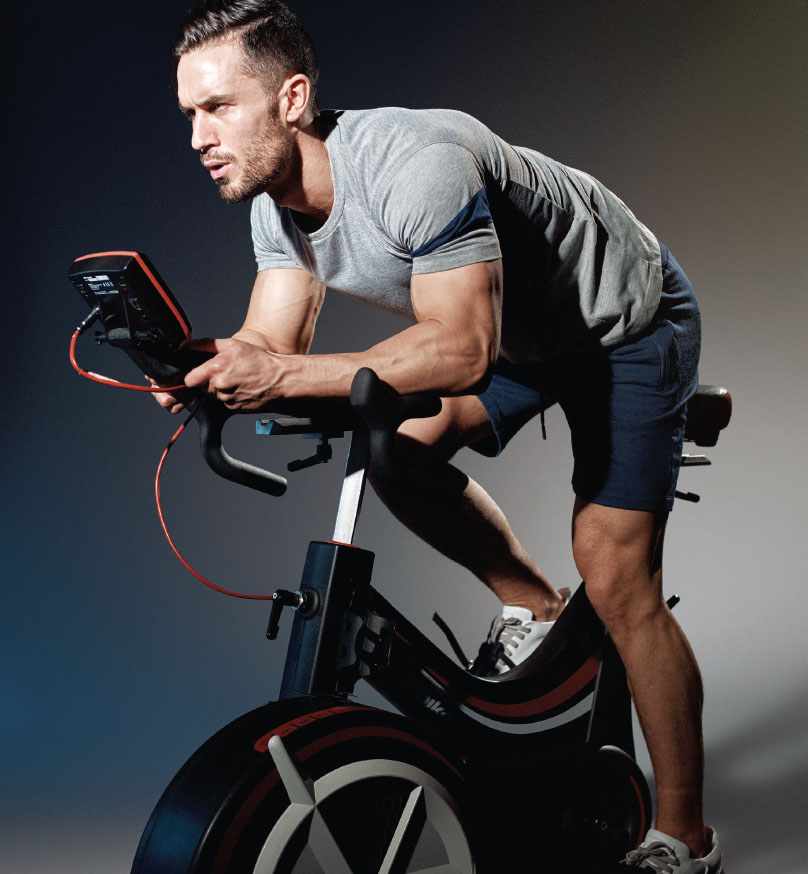
“Doing the same thing time and again is the fastest route to stagnation – and complete boredom,” says Cannon. “To make cardio training effective for fat loss and better health, and to keep your mind motivated, you need to keep switching it up. Try different exercises at different paces.”
“Slow and steady cardio can help you clear your mind, and obviously it’s great for endurance fitness, but if you want to burn more calories you need to get your heart pumping fast by keeping cardio short and intense. A 15-minute burst is plenty if you’re working hard.”
“For years people have argued about whether to do cardio before or after lifting weights, but for the best outcome I recommend always doing your cardio work after weights. You need to be fresh and focused to lift weights well, and you’ll burn more fat if you save the cardio for after.”
“To make cardio training as effective as possible it’s really important to experiment and find the type of training you enjoy. If you look forward to a session then you’re far more likely to attack it with purpose. And the more you apply yourself to it, the more you’ll get out of it.”
Some people think that doing a fat loss workout means slinging the weights around any way you like and racing through your reps because losing fat is about getting your heart rate up. Those people are wrong. That is a part of it, but there’s a smarter way to approach your sessions that will both burn fat and add muscle. The key is to slow down your reps and make sure you can feel the target muscle working. “Time under tension, which means the time your muscles spend working during a set, is important in terms of getting muscle adaptations – even if fat loss is your goal,” says Tirrel Grant, director of Square Mile Fitness (squaremilefitness.com). “Really focus on contracting the muscle and work both the lifting and lowering parts of the move – don’t just let the weights drop down.” Performing your reps like that makes the moves much harder, so although you’re moving the weight slowly, the extra effort required to control them will mean that your heart rate will be high and you’ll get the full calorie-burn benefits.
This workout has five moves, with the first two paired to create a superset. Do all the reps of exercise 1A, rest for 10sec, then do all the reps of 1B, then rest for 60sec. Repeat this for four sets, then move on to exercise 2. The final two moves are also performed as a superset. Keep your abs, lower back and glutes engaged for every rep of every set to keep your body stable and improve power transfer between your upper and lower body.
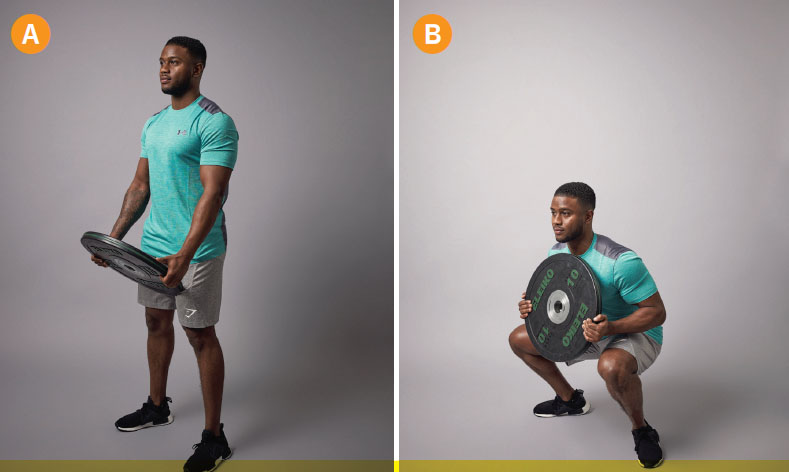
Sets 4
Reps 10-12
Rest 10sec
Bend at the hips and knees with your chest up and your weight on your heels.
“This move is great for building muscle in your quads, hams and glutes,” says Grant.
Pause in the bottom position for one second, then squeeze your glutes to get back up.
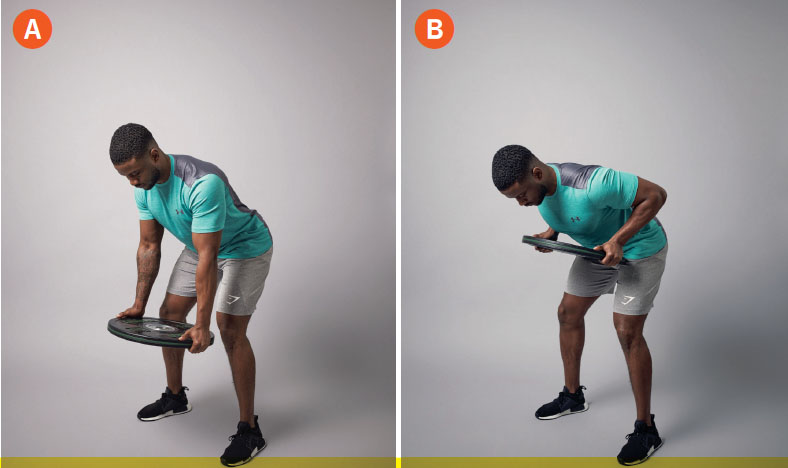
Sets 4
Reps 10-12
Rest 60sec
Bend at the hips and let your arms hang down. Row the weight up to your chest.
“Most guys don’t do enough pulling moves. This helps to build balance,” says Grant.
Squeeze your shoulder blades together for one second at the top of the move.
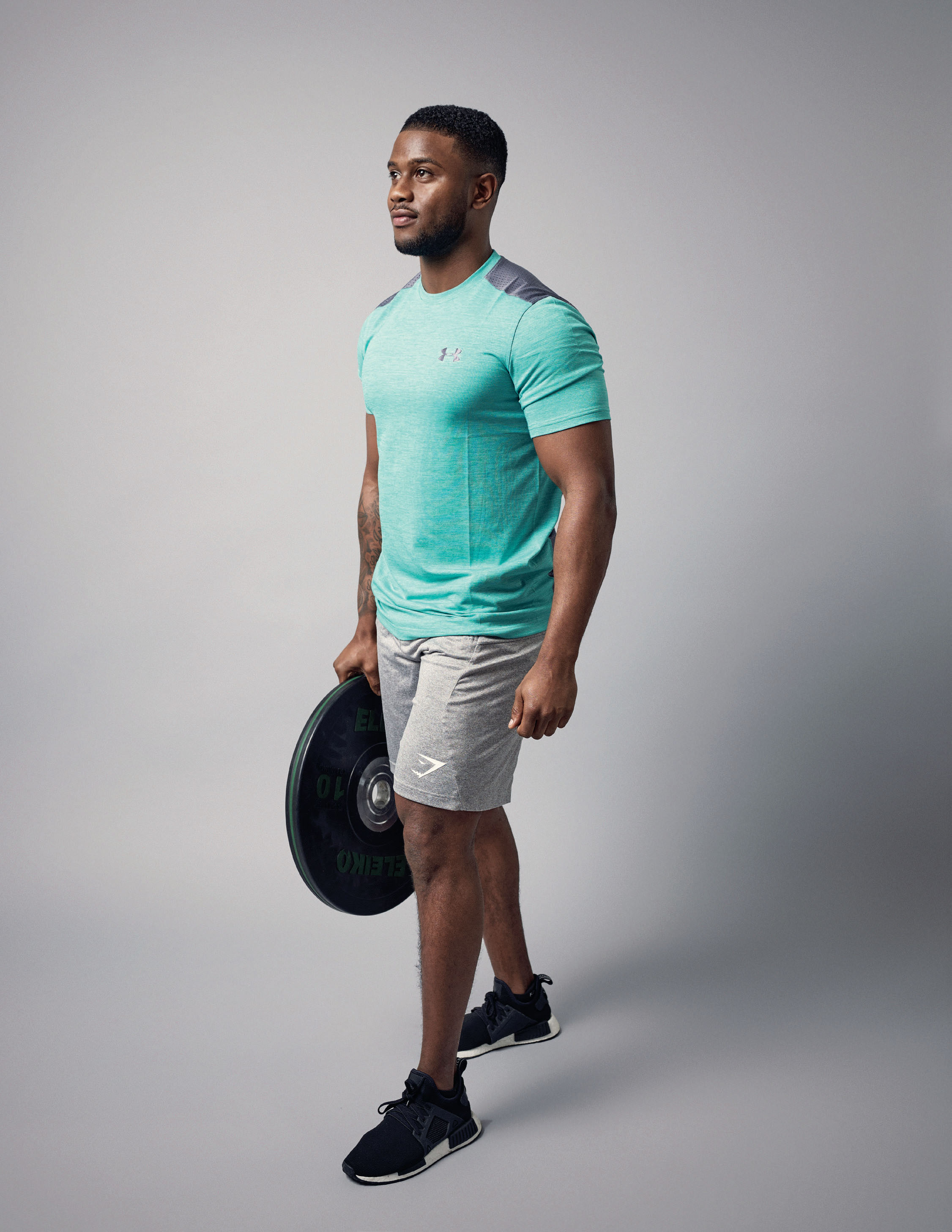
Try to keep your torso upright throughout the carry. This will force you to use your obliques (side abs) to control your torso.
Sets 4
Distance 30m each side
Rest 10sec
Hold a weight plate between your thumb and fingers and walk for 30m.
“Grip, rather than muscle, strength is most people’s limiting factor,” says Grant.
Extend the distance you walk by 10m for each hand.
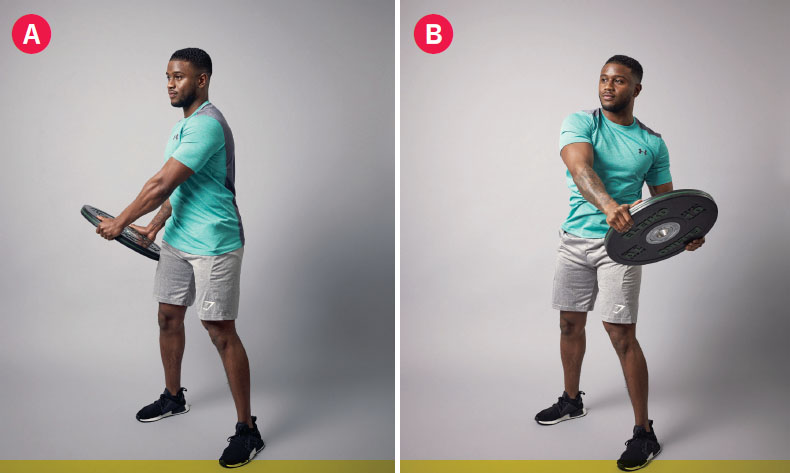
Sets 4
Reps 8-10
Rest 10sec
Move the weight up and across your body, then over your head and down the other side.
“This is great for building rotational strength, which is often ignored,” says Grant.
Doing this explosively, with real power, will recruit the maximum number of muscle fibres.
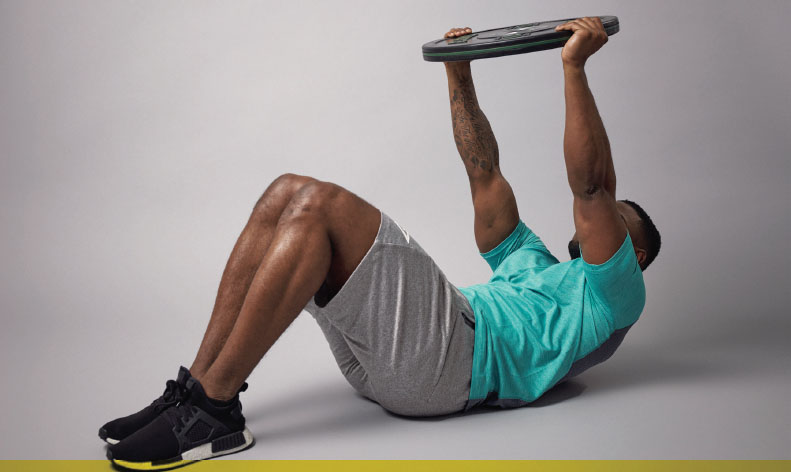
Sets 4
Reps 8-10
Rest 60sec
Lie on your back with your knees bent. Crunch up, keeping your arms straight and vertical.
“Adding weight to an abs move means you’ll work in a rep range that adds size,” says Grant.
Increasing the time you take to lower back to the start will make it harder and more effective.
Power, speed and mental steel are all match-winning tools in the bruising arena of modern rugby, and Wales rugby star George North has fused all three into a devastating combination. The bulldozing winger is a 1.93m,105kg titan who can bench 160kg and squat 255kg, but he unites that brute force with jet-heeled speed (running 40m in under 5sec) and an ice-cold mentality that frees him to perform under intense pressure.
North has 27 tries in 65 appearances for Wales, making him the fourth most successful try-scorer in the nation’s history – and he’s still only 24. But his size, pace and psyche are the result of hard work, smart nutrition, scientific conditioning and mental training, not genetic luck.
“I’m not naturally this big. I’ve had to work hard in the gym and be really strict with my nutrition to keep the mass on and maintain my speed,” says North, who has packed on 26kg of muscle since turning pro. “Even now I fluctuate in size but I work hard to stay on weight. Putting weight on is difficult but when you have to carry it for 80 minutes each Saturday and through hard training sessions you need to get really focused on training and nutrition.”
As the 2017 RBS Six Nations hots up, with Wales aiming to go one better than their second-place finish in 2016, North discusses his blueprint for physical and psychological domination.
How does your gym training change throughout the year?
It’s about knowing where you are and where you want to go. By where you are, I mean identifying where you are at physically, and how much training load you are used to. By where you are going, I mean what your goal is. For a guy on the street, that might be working for a summer body, whereas for athletes that goal changes throughout the year. Pre-season is about getting bigger. Mid-season is about maintaining it. Then at the end of the season we need to recover and adapt for when the ground is harder and we need to be quicker.
How brutal is pre-season training?
For rugby players, pre-season is really a devil. It is something we have to go through to prepare for the battle on its way. It’s an enjoyable but hard time. You’re trying to get your size and mass and lungs ready for the season ahead but it is a tough old one to get through.

BETTER SQUATTING WITH A BICEPS BONUS
In this squat variation, you hold the barbell in the crook of your arms, adding core stability and biceps work to the mix. “It encouraged better technique on the squat, and can be loaded with more than a goblet squat,” says strength coach Joseph Lightfoot. You’ll also get bigger guns because you hold the bar steady with your biceps in an isometric contraction. Do three sets of six after your heavy squats.
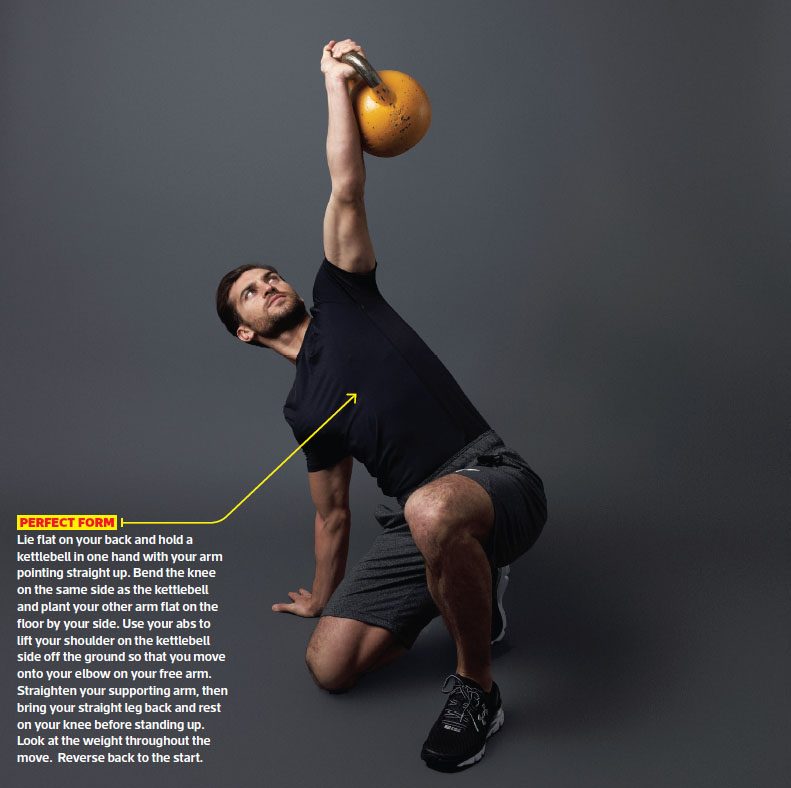
IMPROVE FULL-BODY CO-ORDINATION “These don’t get enough credit,” says personal trainer Olli Foxley. “I’ve heard them called ‘loaded yoga’, which makes sense. When done well they develop mobility, stability and strength through your hips and shoulders. They are also multi-directional and teach a lot of body awareness.” Do two sets of five on each side as part of your warm-up.
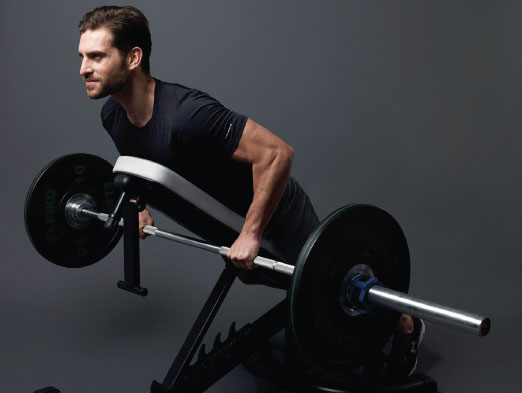
MAKE YOUR SHOULDERS INJURY-PROOF
“A resistance band is the best investment you can make in your shoulder health,” says trainer Adam Wakefield.
“It’s a lifesaver for anyone who spends a lot of time at a desk so their shoulders slump forwards. They don’t put a huge demand on the body so I recommend doing three sets of ten to 20 reps every morning and evening.”
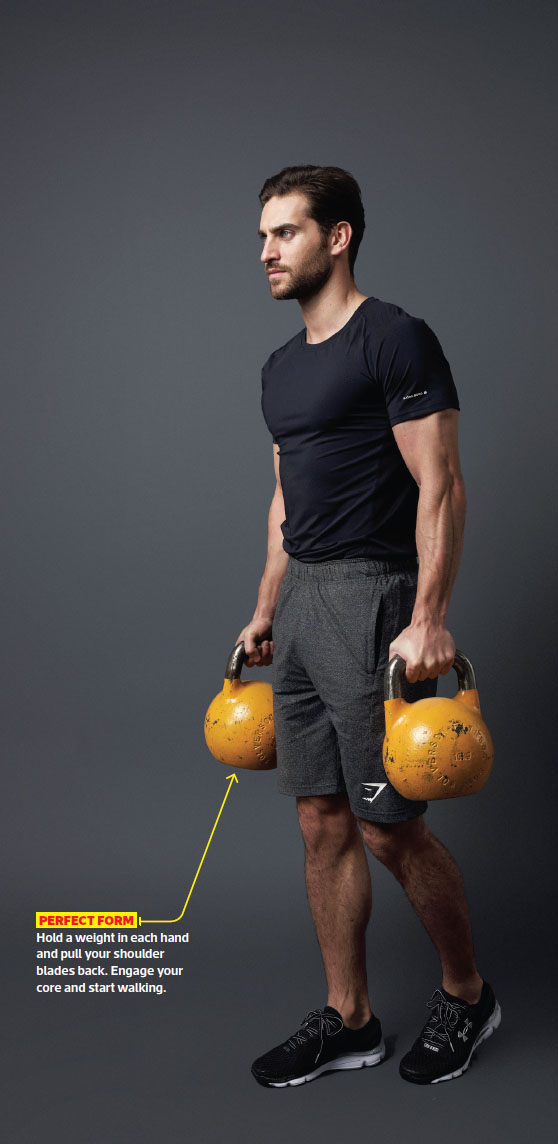
DEVELOP A THICK, BROAD BACK
“One of the few gym machine moves I like,” says Lightfoot. “It encourages great form and movement.” If your gym doesn’t have one, the barbell (or dumbbell) option is still a solid bet. Lie face-down on a bench inclined at roughly 45˚, and row by pulling your elbows behind you and your shoulder blades together.
BUILD LEAN FULL-BODY MUSCLE
The farmer’s walk is the classic, but almost every type of carry works. “Picking up something heavy and carrying it will improve your grip, shoulder health and upper body posture… and it has a huge metabolic effect, so it’ll burn fat too,” says Foxley. Use a carry as a finisher: just pick a distance and a weight, and don’t stop until you’re over the line.
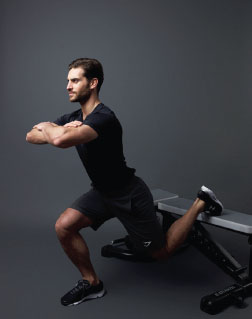
GROW BIGGER LEGS, BARBELL-FREE
“Most people who’ve done these properly hate them,” says Wakefield. “They cause such a huge burn in your quads, hamstrings and glutes that just three sets of ten reps, even with only your bodyweight, can be too much for some people. But they’re worth doing: as well as working the major muscles of the lower body they also train your core, balance and co-ordination. I put these at the forefront of most clients’ leg training because they provide a large stimulus for increasing muscle strength and size.”
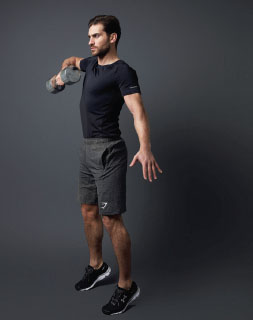
HARNESS HASSLE-FREE POWER
“These have gone out of fashion, but they’re safer than trying to perform the barbell snatch and still provide a lot of the benefits,” says Wakefield. “The initial drive to move the weight from the floor is actually done by ‘pushing’ your feet into the floor while at the same time pulling with your arm and shoulder muscles. As the weight moves overhead, you need to keep your core braced to ‘catch’ it. There isn’t a single muscle group that doesn’t get worked during a dumbbell snatch.”
Willpower is overrated. According to three decades’ worth of research, by relying on grit and determination to eat a healthier diet, you’re setting yourself up for a fall – not just ploughing through finite resources that you could use better on something else, but dooming yourself to an eventual crash that ends with you sitting amid piles of Fondant Fancy wrappers, blood sugar levels through the ceiling.
Mercifully, though, there’s a better way. By putting systems in place to check your hunger before it starts, you’ll eat better effortlessly, leaving your willpower intact for your workout. Here’s how it’s done.

“Keep a glass or bottle of water within reach in the office or when watching TV,” says food psychologist Brian Wansink, author of Slim By Design: Mindless Eating Solutions For Everyday Life. The logic – you’re more likely to grab things within arm’s reach – works in reverse, so ensure sugar-heavy foods require a trip to the kitchen.

“In a study, we asked people to move all their fruits and vegetables onto the top shelf of their fridge and less healthy foods down into the crisper,” says Wansink. “After one week, they reported eating nearly three times as much fruit and veg as they had the week before.”
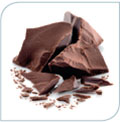
In a 2013 study published in the journal Food Quality And Preference, volunteers who ate bite-sized portions of chocolate and crisps were just as satisfied 15 minutes later as ones who ate four times as much. All your brain remembers is the snack: if you can distract yourself until the craving goes, you’re safe

Translation: going pre-sliced is like keeping it loaded. By buying a loaf that needs to be cut – a crusty sourdough, let’s say – you’re putting up a barrier to that next round of toast, and making it less likely that you’ll fire endless sandwiches into your gob. For next-level snack control, keep it in the freezer and defrost one or two slices at a time.

Psychologist Peter Gollwitzer recommends “if > then” thinking, explaining that it overrides your easily-influenced brain with preprogrammed responses. “If I go to the pub, then I’ll drink red wine” is a good example. The trick? Plan your routines ahead of time, while you aren’t short on willpower.
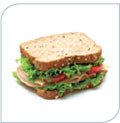
Eating a triangular sandwich at your desk again? A study by Duke University in the US found that 45% of habits are repeated in the same location, cued by routines. Aim to eat a sit-down meal outside the workplace at least a couple of days a week – or even just turn left not right when you leave at lunch to break the subconscious spell.

Researchers from Utrecht University term it “behavioural ironic rebound”: try to avoid bad foods, and you’re doomed to failure. Instead, focus on eating more good ones. Chug water before you head to the Coke machine, say, or have a banana before you buy a Kit Kat. Gradually, the good stuff will push the bad out of your life.

Planning to put together a 13-ingredient mega-salad every night? Doesn’t sound likely, does it? Instead, build the cookery custom with what behavioural expert BJ Fogg calls “micro-habits”. Start by just putting a pan on the stove every night, and then whip up something as simple as possible, like scrambled eggs. Take it from there.

It’s your new favourite phrase. When cravings hit, use what scientists call a “postponement strategy” to avoid the worst of it, by promising yourself a pint/pizza/slice of apple pie at some unspecified future date. Chances are, once you’re better-fed and hydrated, that future time will never come.

Nobody wants to be the man making sad eyes at the cake trolley. Rather than telling yourself or others that you “can’t” have a slab of Victoria sponge, say you “don’t” eat cake (or, for less finality, that it’s not something you’re doing right now). You’ll reframe yourself in your own mind as a more disciplined, less temptable person.